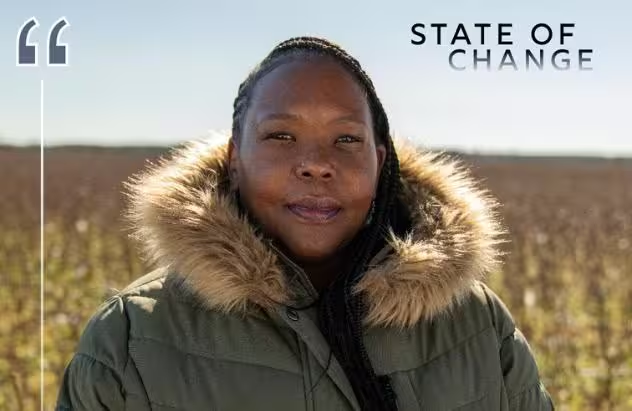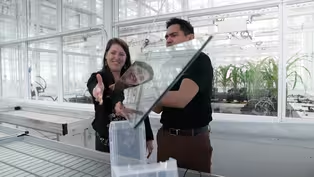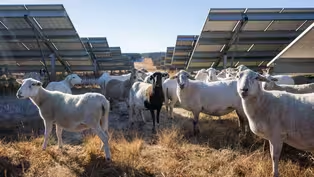
How Sheep Make Solar Energy Production Easier
Clip: Special | 7m 7sVideo has Closed Captions
Sheep and solar panels work hand in hand to generate enough power for a small town.
Solar energy installations have the potential to generate a lot of much-needed electricity. A 20-megawatt installation in rural NC can provide enough power for nearby towns, but fields of solar panels require maintenance. The solution? Sheep. Meet the people behind Montgomery Sheep Farm, a farm in Biscoe, NC, using an innovative combination of agriculture and solar power known as agrivoltaics.
Problems playing video? | Closed Captioning Feedback
Problems playing video? | Closed Captioning Feedback
State of Change is a local public television program presented by PBS NC
State of Change is part of the Pulitzer Center’s Connected Coastlines reporting initiative. For more information, go to https://pulitzercenter.org/connected-coastlines.

How Sheep Make Solar Energy Production Easier
Clip: Special | 7m 7sVideo has Closed Captions
Solar energy installations have the potential to generate a lot of much-needed electricity. A 20-megawatt installation in rural NC can provide enough power for nearby towns, but fields of solar panels require maintenance. The solution? Sheep. Meet the people behind Montgomery Sheep Farm, a farm in Biscoe, NC, using an innovative combination of agriculture and solar power known as agrivoltaics.
Problems playing video? | Closed Captioning Feedback
How to Watch State of Change
State of Change is available to stream on pbs.org and the free PBS App, available on iPhone, Apple TV, Android TV, Android smartphones, Amazon Fire TV, Amazon Fire Tablet, Roku, Samsung Smart TV, and Vizio.

Explore More from State of Change
Hear from North Carolinians about climate change effects & innovative solutions across the state.[ethereal music] - I think you can only disobey the laws of gravity so long.
Solar really is the most economical gravitational force for energy generation.
Solar is inexpensive, it's easy to put almost anywhere, and it makes an ideal place where agricultures can also thrive if you plan early in the design and layout phase.
[sheep bleats] Come on!
[sheep bleats] Come on, big mamas!
Development in general can really occupy a lot of what was previously farmland, and that's not necessarily true with solar farm.
This site, for example, wasn't being used for agriculture at all, but after we finished solar, now all 200 acres are put into agriculture.
The word that's been used to describe what we're doing here is "agrivoltaics".
The "agri" part means agriculture, where we're using livestock to maintain the vegetation underneath the solar panels.
The "voltaics" part of that is photovoltaics, where we're converting light into electricity.
[futuristic music] This is called the Montgomery Sheep Farm.
Nedal has always, with this family, raised sheep and loved animals, and he was extremely eager to have the opportunity to be the farm manager on this farm.
His wife, Lucy, and his children work on the farm.
We use this as kind of a research station.
- We had to kind of prove that it really made sense to raise sheep on solar farms, and we've been doing that now for several years.
This is our innovation station, where we have school classes, we have farm dinners, and an educational place for people to come and stay and see how it really works.
The model is we partner with local farmers where the solar sites are and they bring their sheep.
After a while doing that, we figured we need a market for our lamb.
I grew up in Norway and I grew up with lamb salami.
That's a pretty common thing to have on the table.
We have the lamb salami.
We have all different types of lamb cuts that's kind of hard to find other places.
We utilize the whole animal.
We do dog bones for, y'know, some of the bones is really good for dogs.
And we do have also a sausage that's a garlic bratwurst which is good.
We get a lot of positive feedback.
People enjoy coming out, see the farm, see the operation, come here, have dinner outside, meet new people and enjoy a different type of food.
[gentle electronic music] - The Montgomery Sheep Farm has a 20-megawatt A/C solar panel installation.
So during sunlight hours, we're generating 20 megawatts of power, which is, if you break that down into how much power the average home consumes on a yearly basis, that's about the same as what 3,000 homes would consume of power.
That power is transported here to this substation, and you can think about it like water, right?
The water that's coming in these big pipes on transmission lines are looking at this substation and saying, "hey, do we need to add more water?"
If the Montgomery Sheep Farm has generated enough power that the bucket is full, then that power will go to the next town.
We're in the center of North Carolina, in Montgomery County, and we are just on the edge of the town of Biscoe.
During daylight hours, the Montgomery Sheep Farm is basically filling up the local bucket here, so the power on that transmission line gets transmitted down line.
60% of the US population lives east of the Mississippi, so putting a bunch of solar in the desert and somehow transporting that to the East Coast doesn't make a lot of sense.
We're located 60 miles from Charlotte, we're located 60 miles from Raleigh, 40 miles from Greensboro, so in a sense, we're in a rural part of the state, but we're certainly not in the desert in Nevada.
So whatever we generate here is very closely linked to, y'know, what people in the utility industry call our load centers, the larger cities where we need a lot of power.
I think what makes the most sense is creating those jobs, manufacturing the equipment here, where people live and where they use the electricity itself.
[playful music] Normally, you'll see the sheep kind of attracted to being underneath the panels because of the environment it creates.
In the winter, you're protected from snow and rain and whatnot, but in the summer, you're protected from the heat.
The solar panels do two things.
One is they kind of mimic what trees do.
They create shade that lowers the temperature on different parts of the soil.
So underneath the solar panels, you have vegetation like clover and fescue that don't normally grow in North Carolina in the middle of the summer.
And you can very clearly see that line where the sun hit during the summer months and created this different type of grass.
Bermuda or crab grass are hot weather grasses.
So you've got this diversity in vegetation, which is good for their diet.
The waste of the animal is helping to fertilize the soil as well.
So before we had a solar farm and before we had sheep, there wasn't much organic matter in the soil, but now you see how thick it is?
So that's really good to regenerate the health of the soil.
It's a really neat ecosystem as solar farm, because they have kind of the best of both worlds.
[bright music] By 2016, we had the second most solar installed in the country here in North Carolina.
Because of some of the legislative and regulatory changes, a lot of the market that was here in North Carolina has moved to other states.
We've gone from number two in the country, now we're number four and we're falling pretty fast.
So it's something that we need to get together with and find a solution that allows us to generate the power we need cleanly, affordably, and safely.
[gentle music fades]
Can solar panels and crops share the sun in the same place?
Video has Closed Captions
Clip: Special | 7m 16s | Could we redesign solar panels so we can harvest crops and renewable energy in the same space? (7m 16s)
Preview | State of Change: Solar Harvest
Video has Closed Captions
Preview: Special | 30s | Find out how North Carolinians are generating solar energy alongside agriculture. (30s)
Providing Support for PBS.org
Learn Moreabout PBS online sponsorshipSupport for PBS provided by:
State of Change is a local public television program presented by PBS NC
State of Change is part of the Pulitzer Center’s Connected Coastlines reporting initiative. For more information, go to https://pulitzercenter.org/connected-coastlines.













